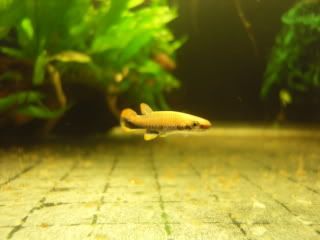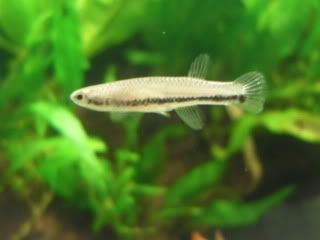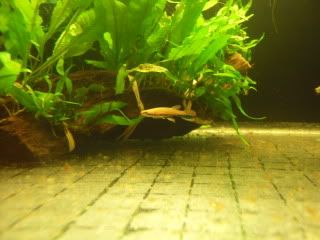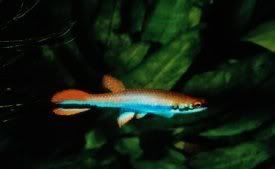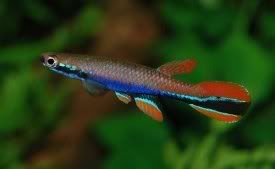Retirement and forum shutdown (17 Jan 2022)
Hi,
John Howell who has managed the forum for years is getting on and wishes to retire from the role of managing it.
Over the years, he has managed the forum through good days and bad days and he has always been fair.
He has managed to bring his passion for fish keeping to the forum and keep it going for so long.
I wish to thank John for his hard work in keeping the forum going.
With John wishing to "retire" from the role of managing the forum and the forum receiving very little traffic, I think we must agree that forum has come to a natural conclusion and it's time to put it to rest.
I am proposing that the forum be made read-only from March 2022 onwards and that no new users or content be created. The website is still registered for several more years, so the content will still be accessible but no new topics or replies will be allowed.
If there is interest from the ITFS or other fish keeping clubs, we may redirect traffic to them or to a Facebook group but will not actively manage it.
I'd like to thank everyone over the years who helped with forum, posted a reply, started a new topic, ask a question and helped a newbie in fish keeping. And thank you to the sponsors who helped us along the away. Hopefully it made the hobby stronger.
I'd especially like to thank John Howell and Valerie Rousseau for all of their contributions, without them the forum would have never been has successful.
Thank you
Darragh Sherwin
Rivulus Xiphidius - Killiefish
- Andrew (Andrew Taaffe)
-
 Topic Author
Topic Author
- Offline
- Premium Member
-

- Posts: 580
- Thank you received: 52
Saw the article in TFH and got me surfing
www.itrainsfishes.net/content/biotopes/secondary_forest.php
ITFS Club Secretary
email: This email address is being protected from spambots. You need JavaScript enabled to view it.
see the ITFS tab above for more information www.irishfishkeepers.com/index.php/itfs
Please Log in to join the conversation.
- JohnH (John)
-

- Offline
- Administrator
-

- Posts: 6067
- Thank you received: 857
Perhaps it's the fact that they don't regularly appear on importers' lists but my suggestion would be to send a few queries to Sponsors...it could just happen that if enough customers show an interest they might investigate further.
Alternatively you could do a bit of further searching for their eggs and hatch them yourself - I know a few Forum members (not least being yours truly) who would buy any surplus fry from you.
John
ps Platty would be the man to talk to - he has several contacts in the Killifish world.
Location:
N. Tipp
We're just two lost souls swimming in a fish bowl - year after year.
ITFS member.
It's a long way to Tipperary.
Please Log in to join the conversation.
- Zoom (Zoom)
- Offline
- Junior Member
-

- Posts: 210
- Thank you received: 3
I had a trio of them I picked up in the UK but unfortunatly I lost the male before I got them to spawn.(like many other trio's I got
Please Log in to join the conversation.
- sheag35 (Seamus Gillespie)
-

- Offline
- Platinum Member
-

- 086 8442267
- Posts: 2740
- Thank you received: 274
Fishkeeping the Only way to get wet and wild
currently 25 tanks, and breeding is the aim of everything i keep
location:Limerick
Please Log in to join the conversation.
- Andrew (Andrew Taaffe)
-
 Topic Author
Topic Author
- Offline
- Premium Member
-

- Posts: 580
- Thank you received: 52
ITFS Club Secretary
email: This email address is being protected from spambots. You need JavaScript enabled to view it.
see the ITFS tab above for more information www.irishfishkeepers.com/index.php/itfs
Please Log in to join the conversation.
- Puddlefish (Colin McCourt)
-

- Offline
- Senior Member
-

- Posts: 347
- Thank you received: 10
Here is an excerpt of an article I wrote for a national association newsletter on the subject.
I had been looking at trying to re-introduce Rivulus xiphidius back into my fish list for some time now. After chasing this species for many months from one end of the globe to the other I eventually found a chap in Spain who was willing to help me with my plight. It was the begining of August when I first made initial contact with my fellow killifish enthusiast. He had quite a few pairs at the time along with some Rivulus speciosus F1 which I also acquired.
The weather in Spain was too warm at that time to even contemplate sending fish so I had to wait until September for the transfer to proceed.
I was contacted again early September to inform me that he was ready to get the operation underway and he was dispatching four pair of Rivulus xiphidius Crique Boulanger and one pair of Rivulus speciosus PCCC 08/7 (f1).
The fish were being sent via the Spanish postal service Correos and were being sent in express fashion (Urgente),(Sat 12th Sept) with an informed delivery time of 3-6 days for UK delivery. I duly thanked the guy for all his help and correspondence in helping to re-attain this beautiful South American species.
The days went by and I waited and waited, still no sign of a package. I used the Spanish tracking code he gave me so I was able to assertain that the consignment had left Spain on the Monday (14th Sept). So I knew they were in transit. Unfortunately I couldn't track the parcel any further as Royal Mail's website doesn't track incoming International mail. So I'd just have to wait it out. Then a bit of bad news in the form of sporadic postal strikes hit home that I may never ever see the package let alone the thought of ever getting the fish to these shores alive. Just my luck. Again I waited. A week went by, I'd been rushing home from work each day discarding the opportunity of a quite a few hours overtime. Still nothing.
After seven whole days I began to loose the faith. They'll all be dead by now I would constantly inform the missus. Another week passed and by this time I was looking to re-start my search for XIP and the prospect of shelling out another couple of hundred pounds was not an exciting prospect.
Then on Saturday the 26th of September I arrived home from work at 11am to be informed by my wife that my parcel had eventually arrived and she had placed them on top of a tank to warm a little.
At least they were here but in all likelihood they'd be dead.
As the wife left for work, I was just about to make myself a cup of coffee when curiosity got the better of me and I ripped open the box.....
The box was just a flimsy standard cardboard mailing box with the usual stamps and stickers around it. Internally there were copious amounts of shredded paper and filter floss. Devoid of the usual polystyrene box, heatpacks and heavy internal insulation that we are so used to seeing I didn't hold out much hope of any sign of life.
Evidence of my frantic box opening techniques
As I foraged for the contents (fish bags) I managed to extract the first of such. A couple of Kordon Breathable bags no bigger than a couple of golf balls tied together at the top with elastic bands. No air in these bags (not needed) You can imagine my excitment as the contents of the bags started to shoot about in frantic fashion as they were exposed to the light. (of which they had not seen for two weeks) On closer inspection they were pretty under nourished but remarkably they were in pretty fine fettle considering. The bag was very cold so I wasted no time in floating it in a pre set up tank.
I extracted four more pairs of kordon bags from the mailing box, each time fish were thrashing about within, again the bags were very cold (around 56'F)
All the bags were now floating in a tank of warm aquarium water.
I mulled around for an hour or so as the temps were equalising (finally got that cup of Latte) contemplating what the next stage would entail and how I wouldn't want to muck things up having got this far. Getting the fish from bags to tank without any mishaps was now my uppermost primary concern.
I needed to test the water in one of the bags. I utilised a small show tank and carefully cut open one of the bags with a XIP male in and tiped the contents into the small vessel. The pH was 6.8 which wasn't too bad.
The TDS was 195ppm (11dKH) which again was survivable, but the chill might have affected them.
I managed to get a main tank to near as poss to the bag conditions and using a drip process I set about acclimatising all the fish to this.
After a couple of hours messing about the fish were ready for their new homes. The time of release was nigh. I carefully placed pair after pair into
small margarine tubs and covered them as Rivulus species are renowned pole vaulters. I placed the tubs into their respective tanks and removed the lids and then slowly submerged the tub until the fish vacated.
They were all now in and what's more they all were alive.
I now left them to their own devices for a couple of hours to settle in the darkened tanks.
I knew the fish were malnourished so I administered small amounts of newly hatched Brineshrimp and Grindalworm for them to forage on when they were ready. The females were the first off the mark and tucked into the food which they sorely lacked. The males were being their usual selves, as seems to be the norm in killifish feeding habits, initially letting the females get in there first and whenever they feel safe, then the males would join the fray, kicking the females to one side.
So everything is well at present, although the water conditions are nowhere near what they should be at the moment from a breeding standpoint. This will have to be addressed over the coming weeks.
For now I'm just glad that they are all safe and feeding.
Who would have thought that such a warm water killi could survive such a long transit time, in such flimsy packaging and plunging UK night-time temperatures......Amazing.
This article is about a year old and is a follow up to an original on breeding XIP.
I presently have some surplus stock and I may be looking to sell or exchange.
Any interested parties should get in touch via the usual means.
Regards
Colin
Please Log in to join the conversation.
- Puddlefish (Colin McCourt)
-

- Offline
- Senior Member
-

- Posts: 347
- Thank you received: 10
Well I have written many an article for various clubs and forums but none with so much affection for a species of killifish than this little beauty. Maybe the fact that it took me over 10 years to aquire my initial stock that Rivulus xiphidius stands up there as my most favourite killifish species of all time. Now it may not be the most stunning of specimens along side some of the African species but when the morning light shines on a fully grown male it's surely a sight to behold. Theres just something about this species that just gives me a buzz each time I look into my tanks. You may never see or own this species but I would like to put something down on e-paper regarding my experiences with this South American jewel.
Rivulus xiphidius (Crique Boulanger)
General
My first encounter with this small rivulin from French Guyana was way back in the mid eighties at a BKA Convention held on the Leeds University campus. I was a member of the Collingham Group (small group of avid enthusiasts affiliated to the BKA) It was my duty to bag the peat from the show tanks of any annual / semi annual / peat spawner and peat divers tanks and to clearly label them with the species name, location and any valid collection codes. We had a guest speaker on the Sunday by the name of Fredrich Bitter from Germany who is now a world renouned fish importer. He had brought over a couple of F1 pairs which were entered into the show and then subsequently onto the following auction. I was awestruck by their beauty, even back then.
Needless to say they caused a bit of a stir in the auction room, and they went for a pretty penny. It wasn't until the winter of 95 that I inadvertantly stumbled upon this species again, I'd moved back home to Northern Ireland following the death of my mother., and was looking around for prospective killifish stock. I was invited to a fellow members house near the coast and he brought me into his fish-house. It was no pristine palace but boy he could breed fish. Wall to wall killifish tanks, I was like the proverbial kid in a sweet shop. Then I spied Xiphidius, tanks of the bloomin things of varying sizes from fry to adults. So you can imagine my extreme gratatude when he gave me 4 pairs for free on the proviso that I returned to him some offspring. I now had my stock WOW!
Rivulus xiphidius is a relatively small killifish from Surinam in French Guyana which inhabits small slow moving watercourses which is very soft and acidic and has a certain amount of stagnation and rotting vegetation so I had to produce something similar in their tank if I hoped to have any chance of breeding them. The adults attain a size of 45mm for the male and the female is considerably smaller at 30mm. I set up a few tanks with collected filtered rainwater mixed with tapwater roughly to a 75/25 ratio. Which came out fairly soft dH4 and a pH around 5, the temperature was kept at the recommended 77'F. They will only accept livefoods so here lay another problem which I needed to overcome so provisions were made to culture paramecium/infusoria, vinegar eel, microworm, grindalworm, whiteworm and vestigal winged fruitfly, This along with newly hatched brineshrimp would form the mainstay of their daily diet. Their tank would be heavily subdued with dense planting and light only entered the tank from the front and to one side. Pretty dark in there. Xiphidius like all rivulin species like to jump, these are amongst the most accomplished carpet surfers out there so an extremly tight fitting lid/coverglass is essential.
Colouration
For me to try and discribe the amazing colouration of an adult male of this species would truely do it a gross injustice so to that end I must refer you to the pictures above which accompany this article.
Sex & Breeding
Breeding this little gem presents quite a few problems, firstly the water conditions have to be whithin the boundaries of its natural habitat in order for the eggs to be viable and hatch without going bad. Possibly the sperm from the male may not survive conditions outside these parameters to sucessfully fertilise the egg. A tank of 8"x12"x10" was afforded to each pair of fish. Water conditions were maintained in or close to dh4, pH5 and 77'F with no artificial lighting. In each tank I provided a chunk of bogwood with a clump of Java fern, Indian fern was also used alongside Java Moss and Salvinia natans as floating cover. Into this tank I also placed one rather large and long floating mop (Dark Green yarn). A small air driven sponge filter was afforded as always and this was set to a slow trickle. Snails were mistakenly added (on the plants) and I had some concern about this at the start, would they eat the eggs. As it turned out I'd no need to worry as the harsh water conditions ment that they didn't survive long at least that particular species didn't.
In this enviorenment they remained, it suited me and the fish really well. I had the added bonus of collecting some eggs from the mops and also they spawned on the plant material and some fry could be reared using the natural method. I performed a 20% waterchange on a weekly basis and I added to this a capfull of Tetra Blackwater Extract. Their water was very dark in colour like weak tea with the tannins from the wood and the extract additive. After around a couple of weeks settling in and feeding well, I decided I'd better check for eggs. I would only pull eggs from the mop. I had to be careful as the fish made themselves very scarce and were to a point very timid. The mop had to be shaken in the tank and I had to assertain that I'd seen both prospective parents in the vessel before I could fully remove the mop. I would then subsequently check for any sign of spawning behaviour. I found eggs all over the mop but prodomitly in the top quarter near the cork. For such a small fish (female) the eggs are suprisingly large. I would say that the fish are not very prolific spawners compared to their African counterparts and I would estimate that they only lay about 6 eggs a day on average. I was told that this was a very good average compared to other breeders. So something must have been to their liking. At least they were spawning and the eggs were viable.
Eggs & Fry Rearing
As I said before the eggs were relatively large compared to the size of the fish. I collected them on a daily basis, Viable eggs are quite hard to touch and can easily be harvested from the mop. As these fish were of a delicate nature I placed no more than 6 eggs in a floating margarine tub with a sprig of Salvinia with a water depth of around 30mm. Loads of tubs were floating around the fish-house tanks at that particular time. The eggs hatch in about 16 days at a temp of 77'F. Its my belief that the fry of this species are too small upon hatching to accept anything other than infusorians as their first food so I added some on a daily bases for the first couple of days. (See Culturing Infusoria in the pinned section) You must be carefull not to overfeed and remove and replenish fresh water diligently on a daily basis. After a couple of days the fry will or should be large enough to move on to microworm and newly hatched brineshrimp. I tried vinegar eel but I didn't feel that this was doing any good. So with the fry on to brineshrimp nauplii I thought I could relax, The first hatch I got I lost every one, why I dont know, I had them up on larger foods and was meticulus is cleaning etc. maybe it was a water borne pathogen that claimed them or maybe becaust they are very skittish that I might have shocked them as I moved their container, I simply dont know. Once you approach the fry they dive for cover, remaining motionless, and are really difficult to find. Anyway with each and every subsequent hatch things were getting better. The fry are labouriously slow growing for the first few months which is when the males start to show some signs of colouration and its not until they are around a 10-12 mths old that they are sexually mature. The fry that subsequently hatch in the parents tank were sometimes caught using various methods including a tablespoon method (which need some practice I can tell you) But a lot of the time these fry were left to their own devices, they would have found infusorians in abundance given the amount of plant matter that was afforded to those tanks and they subsequently made as good an adult fish if not better and more robust than the hand reared ones. Just a little note on male rivalry here, the males do not tolerate each other too well and I like to grade (according to size) and seperate them as the need arises. Keeping a lot of males together without female company seems to quell this trait somewhat.
Summary
I, personall found this species pretty easy to breed given the proper water conditions and husbandry, the initial first few days after hatching and the need/ability not to shock the fish seems to be the only major stumbling block to rearing a batch of these sucessfully, They take quite a while to mature but it is truely worth the effort involved. This is the only killifish species (when breeding) kept me in the fish-house way into the wee small hours of the morning. You only get out of things what you are prepared to put in, I always say.
This is a beauty if a fish and one that will always have a place in my tanks wherever I may roam.
Breeding Overview
Tank size: 8"x12"x10"
Decor: Adults - Dense plant laden tank with bogwood (Java Fern, Java Moss, Indian Fern and Salvinia natans) with large floating mop, Fry - Salvinia natans and Java moss
Water: Soft dh4 - pH 5.0
Temperature: 77 F
Waterchanges: Weekly (20%) for breeders and Daily (20%) for fry.
Filtration: Air driven sponge filters set to a trickle.
Feeding: Livefoods only, little and often especially fry, remember to syphon off uneaten food.
Lighting: no artificial lighting.
Note:-
These fish along with other Rivulus species are excellent jumpers, they sometimes move from watercourse to watercourse in their natural habitats and will cover land to do so, so a tight fitting aquarium lid or coverglass is not only essential, it's a must.
I hope you enjoyed reading yet another personal account from my killifish breeding notes, and maybe some day one of you will aquire this beautiful killifish and use these jottings to help you in your quest to breed this stunning little fish which Mother Nature has seen fit to adorn us with.
Regards
BigC
Please Log in to join the conversation.
- derek (Derek Doyle)
-

- Offline
- Platinum Member
-

- Posts: 1397
- Thank you received: 133
30 tanks specialise in african cichlids, angelfish and various catfish
Please Log in to join the conversation.
- Frontosa (Tim kruger)
-

- Offline
- Premium Member
-

- Posts: 607
- Thank you received: 9
Midlands - in the heart of Ireland.
Keeping and breeding : Frontosa Blue Zaires , Synodontis Petricola , Tropheus Red Rainbow (Kasanga) , Tropheus Moliro . Regulary fry for sale.
Community tank with P.Kribensis and different livebearers.
Please Log in to join the conversation.
- Zoom (Zoom)
- Offline
- Junior Member
-

- Posts: 210
- Thank you received: 3
Are you keeping many killies at the moment?
I'll get back to you on surplus stock if you still have some in the next few weeks.
Thanks
Alan
Please Log in to join the conversation.
- Puddlefish (Colin McCourt)
-

- Offline
- Senior Member
-

- Posts: 347
- Thank you received: 10
I used to keep a lot but nowadays I'm concentrating on one or two.Are you keeping many killies at the moment?
That way I can simplify things and only need to mix one type of water.
I'm also keeping a relatively new species (2009) Aphyosemion campomaanense ABK 07/181
As yet I have no surplus stock.
I do however have a couple of good killi friends up here in the North, (Donald is a member on this forum). We have formed a kind of Killifish Collective and have various species available from time to time.
Look forward to hearing from you Al.I'll get back to you on surplus stock if you still have some in the next few weeks.
Regards
C
Please Log in to join the conversation.




